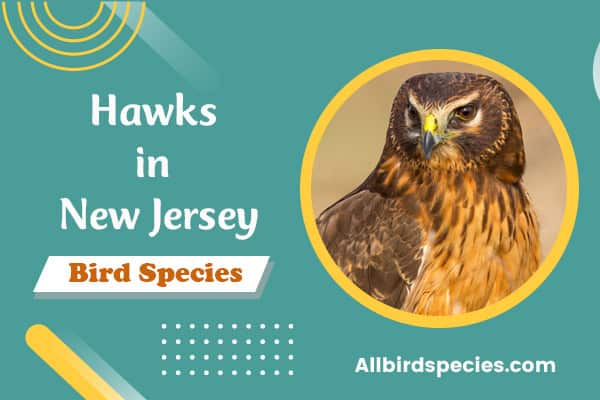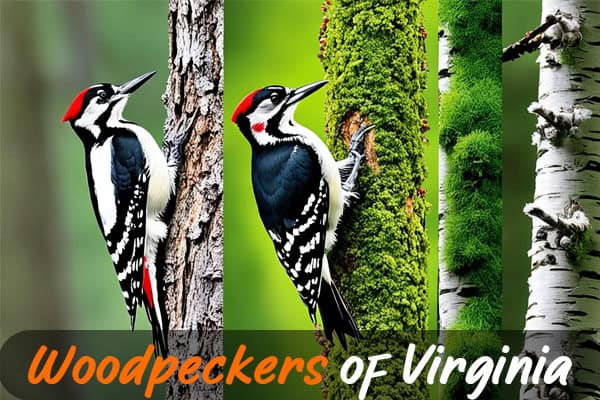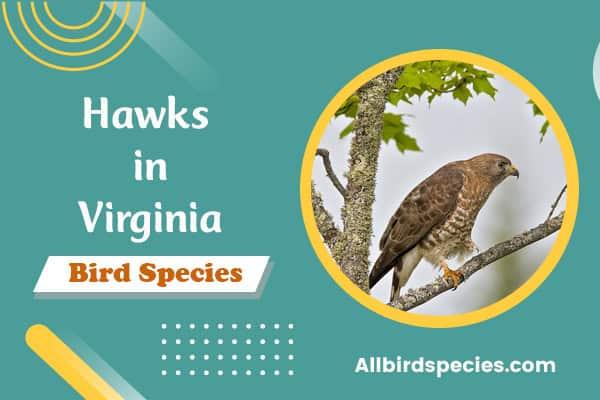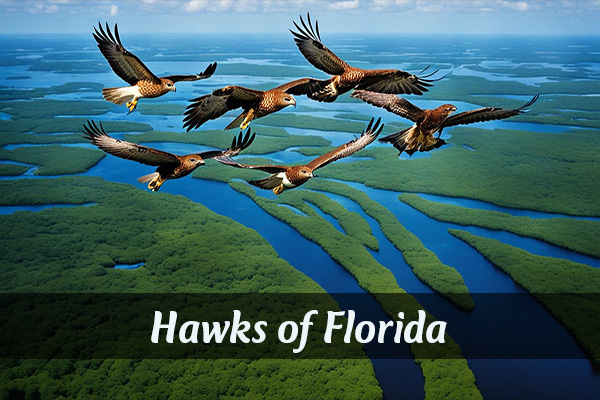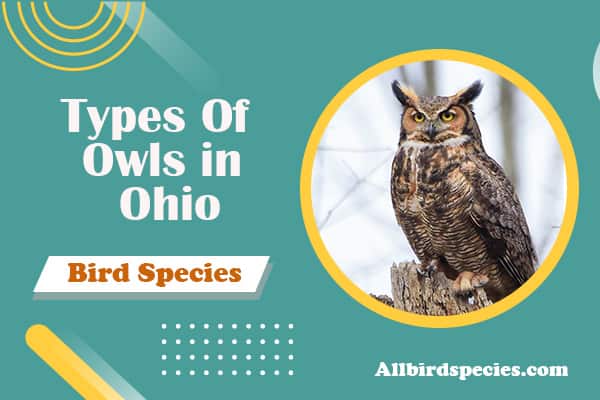8 Types of Hawks in New Jersey (With Photos)
eDid you know that New Jersey is a key spot for migratory hawks? Over 200,000 hawks pass through here during peak migration times. This shows how vital these birds are and how many types there are. We’ll look at eight types of hawks found in New Jersey, perfect for those who love birdwatching.
We’ll explore the unique traits, homes, and ways of these New Jersey hawks, with beautiful photos. Come with us to see the variety of hawks in our skies. Each sighting is a special moment.
1. Red-Tailed Hawk
- Scientific name: Buteo jamaicensis
- Life span: 10-15 years
- Size: (50-65 cm)
- Weight: (900-1460 g)
- Wingspan: (114-133 cm)
The Red-tailed Hawk is a well-known bird in North America. Its large wings and eye-catching colors make it popular among bird lovers. We will look into how to identify the Red-tailed Hawk, where it lives, and what it eats.

Identification and characteristics
The Red-tailed Hawk is easy to spot because of its reddish-brown tail. Adults have different colors, from dark brown to light straw. They have broad wings and a strong body, looking very regal.
Their face has a light head and dark streaks, making them stand out. Young hawks look different, with a more mixed-up look. This makes them harder to tell apart from adults.
Habitat and distribution
Knowing where the Red-tailed hawks live helps us find them. They like open areas and woodland edges. You can see them flying over fields, sitting on telephone poles, or in big trees by roads and farms.
They can live in many places, from cities to deep forests. This makes them one of the most common hawks in North America.
Diet and hunting techniques
Red-tailed Hawks mainly eat small mammals like voles and rabbits. They use a smart hunting method. They fly high to look for food and can spot movement from far away.
When they see prey, they dive fast to catch it. They also eat birds and reptiles, showing they are versatile hunters.
2. Red-shouldered Hawk
- Scientific name: Buteo lineatus
- Life span: Up to 12 years
- Size: (45-50 cm)
- Weight: (350-740 g)
- Wingspan: (100-122 cm)
The Red-shouldered Hawk is a fascinating bird that lives in wooded areas in New Jersey. It stands out with its unique looks and lively actions. This bird shows off a mix of colors and a complex social life.

Physical features and behavior
This hawk is easy to spot because of its reddish-brown shoulders and wide wings. These features make it stand out in the sky. Its colors help it blend in with the trees, making it a great hunter.
These hawks are known for their loud calls. They use these to talk to their mates or mark their territory. They fly with a mix of flaps and glides, showing off their skill and grace.
Nesting habits and reproductive traits
Red-shouldered Hawks build their nests high up in trees, often near water. They use sticks, leaves, and other materials to make their nests safe and cozy for their babies.
Both parents work together during the breeding season. They build the nest, feed the young, and take turns caring for their chicks. This teamwork helps their babies survive and shows how much they care for their family.
3. Broad-Winged Hawk
- Scientific name: Buteo platypterus
- Life span: 12 years
- Size: (34-44 cm)
- Weight: (265-560 g)
- Wingspan: (81-100 cm)
The Broad-winged Hawk is a fascinating bird that captures the hearts of bird lovers. Its amazing migration patterns and unique eating habits are a sight to see. These hawks migrate in large groups during spring and fall, making their presence known.

Watching the Broad-winged Hawk migration is truly spectacular. Thousands of them fly through New Jersey, creating a breathtaking view.
Migratory patterns and seasonal visibility
This hawk is most visible during migration, usually in September and October. During these months, we see Broad-winged Hawks flying high in large numbers.
- Travel predominantly during daylight.
- Navigate south to Central America for winter.
- Return north to breed in the spring.
Dietary preferences
The Broad-winged Hawk eats small mammals, birds, and reptiles. Their diet changes based on what’s available. In the breeding season, they hunt in forests. But during migration, they eat whatever they can find along their path.
4. Northern Goshawk
- Scientific name: Accipiter gentilis
- Life span: Up to 15 years
- Size: (61-74 cm)
- Weight: (680-1360g)
- Wingspan: (114-132 cm)
In New Jersey’s wild areas, the Northern Goshawk is a standout with its blue-gray feathers and strong wings. This bird is a top hunter and has traits that make it unique among hawks. Learning about the Northern Goshawk’s traits and where it lives helps us appreciate this amazing bird more.
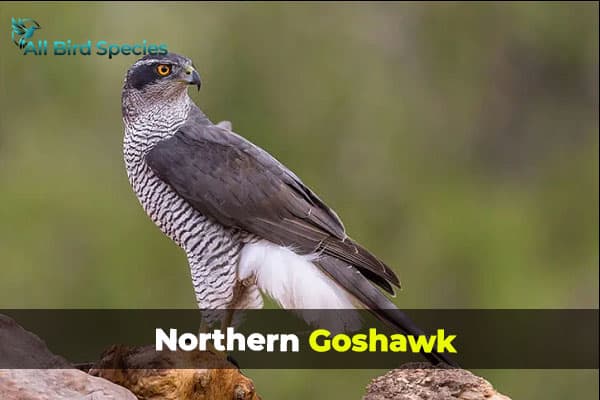
Key traits and habitats
The Northern Goshawk hawks in New Jersey are known for their size and agility. Adult males are about 24 inches long, and females can be a bit bigger. They have sharp claws and great eyesight, perfect for catching birds and small mammals. They live in dense forests, where tall trees give them shelter and places to hunt. These forests are key for their nests and raising their young.
Challenges in observing this species
Watching the Northern Goshawk in the wild can be tough. They like to stay hidden in wooded areas, making them hard to see. They’re shy and will fly away if they feel people are around. Birdwatchers need to be patient and keep a low profile to spot one. Knowing these things makes watching them more rewarding.
| Trait | Description |
|---|---|
| Size | 24 to 26 inches in length |
| Weight | 1.5 to 3.5 pounds |
| Plumage | Blue-gray with striking white markings |
| Habitat | Dense forests with ample tree cover |
| Diet | Birds, small mammals, and occasionally reptiles |
5. Rough-Legged Hawk
- Scientific name: Buteo lagopus
- Life span: Up to 15 years
- Size: (46-51 cm)
- Weight: (680-1470g)
- Wingspan: (132-137 cm)
The Rough-legged Hawk is a fascinating bird that visits New Jersey in the winter. We can easily spot this raptor by its unique features, like the feathered legs. These legs keep it warm in the cold weather. This helps them live in harsher climates than other hawks.

These birds like open fields and wide grasslands for hunting. They often sit on fence posts or tree branches, looking for movement. The Rough-legged Hawk can live in different places, making it a standout in New Jersey’s winter.
Their diet includes small mammals like voles and rabbits and some birds. They hunt using a hovering method. They stay still in the air before diving down on their prey. This hunting skill helps them survive when food is hard to find in the cold months.
6. Sharp-Shinned Hawk
- Scientific name: Accipiter striatus
- Life span: 5 years
- Size: (24-34 cm)
- Weight: (87-218 g)
- Wingspan: (43-56 cm)
The Sharp-Shinned Hawk is the smallest hawks in New Jersey, catching the eye with its amazing flying skills. It chases small birds for food, making it a favorite among birdwatchers. Learning about its identification, behavior, and diet helps us appreciate this bird more.

Identification and common behaviors
Spotting a Sharp-Shinned Hawk is easy with its slate-blue back and reddish-brown breast. It has short wings and a long tail with bands. Young ones look more brown and streaked. This hawk moves fast through trees, catching birds off guard.
Feeding habits and prey selection
This hawk eats mostly small birds like sparrows and finches. Sometimes, it goes after small mammals if birds are scarce. It waits quietly before chasing its prey with speed. Its eating habits affect its migration and where it lives.
| Feature | Details |
|---|---|
| Size | About 9-13 inches in length |
| Wingspan | 21-28 inches |
| Primary Diet | Small birds, occasionally small mammals |
| Common Behavior | Stealthy predator, prefers wooded areas |
7. Cooper’s Hawk
- Scientific name: Accipiter cooperii
- Life span: 12 years
- Size: (37-39 cm)
- Weight: (220-410 g)
- Wingspan: (62-90 cm)
The Cooper’s Hawks in New jersey is a bird of prey that looks similar to the Sharp-Shinned Hawk. But, they have key differences that make them unique. We will look into what makes the Cooper’s Hawk stand out, their breeding habits, and how they nest in different places.

Differences from Sharp-Shinned Hawk
The Cooper’s Hawk is bigger and looks more robust than the Sharp-Shinned Hawk. They also have different feathers and tails. The Cooper’s Hawk has a rounded tail with wide dark bands. This is unlike the Sharp-Shinned Hawk’s squared tail. These differences help us tell them apart in the wild.
Breeding season and nesting behavior
Cooper’s Hawks breed in the spring, with females laying three to seven eggs. They build their nests high up in trees. The female takes care of the eggs while the male finds food. This teamwork is an interesting part of their breeding.
The young hawks leave the nest about six weeks after they hatch. This is a big step in their growth.
| Characteristic | Cooper’s Hawk | Sharp-Shinned Hawk |
|---|---|---|
| Size | Medium to large (14-20 inches) | Small (9-13 inches) |
| Tail Shape | Rounded | Squared |
| Coloration | Bluish-gray above, reddish bars below | Slate gray above, white below with fine streaks |
| Nesting Height | Higher in trees | Lower in tree canopies |
8. Northern Harrier
- Scientific name: Circus hudsonius
- Life span: Up to 12 years
- Size: (45-50 cm)
- Weight: (350-740 g)
- Wingspan: (100-122 cm)
The Northern Harrier is a fascinating raptor known for its unique traits and hunting ways. It’s famous for nesting on the ground, unlike many hawks that nest high up. This makes it stand out.

Its perfect home is in open fields, marshes, and grasslands. These places let it easily find food. It helps control rodent populations, playing a key role in its ecosystem.
Learning about the Northern Harrier’s behavior shows us how amazing it is. We see these hawks flying low over the ground, using their sharp eyes to find small animals and birds. Their special face shape helps them hear better, making them better hunters.
The Northern Harrier looks unique too. It has a long tail, and thin wings, and flies beautifully. Males and females look different, with females being bigger and stronger.
Studying the Northern Harrier teaches us about its important role in nature. By understanding this bird, we see how vital it is to protect New Jersey’s biodiversity.
Check Our Previous Articles:
| Hawks in New Jersey |
| Rodrigues Solitaire: Extinct Bird of the Indian Ocean |
| Owls in Virginia |
| Splendid Birds With Hair |
| Types of Blue Birds |
Conclusion
As we finish our look at New Jersey 8 types of hawks, we see how diverse they are. Each hawk, from the Red-Tailed Hawk to the Northern Harrier, plays a special part in nature. They help keep animal populations in check and support biodiversity.
This overview of hawks shows us their beauty and importance. It also shows our big responsibility. We must work hard to protect these birds for the future. By saving their homes and teaching others about them, we make our ecosystem better and enjoy birdwatching more.

